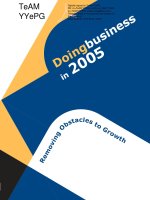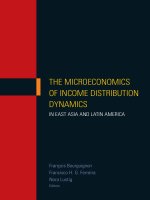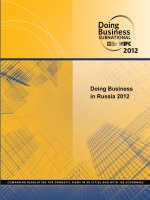Doing Business in 2006- East Asia and Pacific Region
Bạn đang xem bản rút gọn của tài liệu. Xem và tải ngay bản đầy đủ của tài liệu tại đây (388.5 KB, 39 trang )
EMBARGOED:
00:01 GMT September 13, 2005
Not for newswire transmission, posting on
websites, or any other media use until
00:01 GMT Tuesday, September 13, 2005.
(8:01 PM EDT Washington, D.C., Monday
September 12)
A project Benchmarking Business Regulations in 155 Countries
East Asia and Pacific Region
Regional Profile
© 2005 The International Bank for Reconstruction and Development / The World Bank
1818 H Street, NW
Washington, DC 20433
Telephone 202-473-1000
Internet www.worldbank.org
E-mail
The findings, interpretations, and conclusions expressed herein are those of the author(s) and do
not necessarily reflect the views of the Board of Executive Directors of the World Bank or the
governments they represent.
The World Bank does not guarantee the accuracy of the data included in this work. The boundaries,
colors, denominations, and other information shown on any map in this work do not imply any
judgment on the part of the World Bank concerning the legal status of any territory or the
endorsement or acceptance of such boundaries.
Rights and Permissions
The material in this work is copyrighted. Copying and/or transmitting portions or all of this work
without permission may be a violation of applicable law. The World Bank encourages dissemination
of its work and will normally grant permission promptly.
For permission to photocopy or reprint any part of this work, please send a request with complete
information to the Copyright Clearance Center, Inc., 222 Rosewood Drive, Danvers, MA 01923, USA,
telephone 978-750-8400, fax 978-750-4470,
www.copyright.com.
All other queries on rights and licenses, including subsidiary rights, should be addressed to the
Office of the Publisher, World Bank, 1818 H Street NW, Washington, DC 20433, USA, fax 202-522-
2422, e-mail
To order copies of the
Doing Business in 2006
Report, please visit
and click on “Now Available: Doing Business in 2006”.
EMBARGOED:
00:01 GMT September 13, 2005
Not for newswire transmission, posting on
websites, or any other media use until
00:01 GMT Tuesday, September 13, 2005.
(8:01 PM EDT Washington, D.C., Monday
September 12)
Contents
Doing Business in 2006
: An Introduction 4
Starting a Business: Entry Regulation 6
Dealing with Licenses: Building a Warehouse 9
Hiring and Firing Workers: Employment Regulation 12
Registering Property: Regulation of Property Transfers 15
Getting Credit: Legal Rights and Credit Information 18
Protecting Investors: Corporate Governance 22
Trading Across Borders: Imports and Exports 24
Enforcing Contracts: Court Efficiency 28
Paying Taxes: Tax Payable and Compliance 31
Closing a Business: Bankruptcy 34
Reforms: Who is reforming in the region? 37
East Asia and Pacific Re
g
ion
Introduction
A vibrant private sector—with firms investing, creating jobs, and improving productivity—promotes
growth and expands opportunities for poor people. That is why governments around the world have
implemented wide-ranging reforms, including macro-stabilization programs, price liberalization,
privatization, and opening to foreign trade. In many countries, however, entrepreneurial activity
remains limited, poverty high, and growth stagnant. Other countries have spurned orthodox macro
reforms and done well. How so?
Although macro policies are unquestionably important, there is a growing consensus that the quality
of government regulation of business is a major determinant of prosperity. Hong Kong (China)’s
economic success, Botswana’s stellar growth performance, and Hungary’s smooth transition
experience have all been stimulated by a good regulatory environment. But there is little work
measuring specific aspects of regulation and analyzing their impact on economic outcomes, such
as productivity, investment, informality, corruption, unemployment, and poverty. The lack of
systematic knowledge prevents policymakers from assessing how effective their legal and
regulatory systems are and how to design and sequence reforms.
Doing Business in 2006: Creating Jobs
is the third in a series of annual reports investigating
regulations that enhance business activity and those that constrain it. New quantitative indicators on
business regulations and their enforcement can be compared across 155 countries—from
Afghanistan to Zimbabwe—and over time. The indicators are used to analyze economic outcomes
and identify what reforms have worked, where, and why.
The indicators presented and analyzed in
Doing Business
measure government regulation and the
protection of property rights—and their effect on businesses, especially on small and medium-size
domestic firms. First, they document the degree of regulation, such as the number of procedures to
start a business or register commercial property. Second, they gauge regulatory outcomes, such as
the time and cost to enforce a contract, go through bankruptcy, or trade across borders. Third, the
indicators measure the extent of legal protections of property, for example in the protections of
investors against looting by the company directors or the scope of assets that can be used as
collateral according to secured transactions laws. Finally, a new set of indicators documents the tax
burden on businesses.
The data for all sets of indicators are for January 2005. Based on research of laws and regulations,
with input and verification from local government officials, lawyers, business consultants,
accountants and other professionals routinely administering or advising on legal and regulatory
requirements, this methodology offers several advantages. It uses factual information and allows for
multiple interactions with local respondents, clarifying potential misinterpretations of questions. It is
inexpensive, so data can be collected in a large sample of economies.
4
Because the same standard assumptions are applied in the data collection, which are transparent
and easily replicable, comparisons and benchmarks are valid across countries. And the data
highlight not only the extent of obstacles, but also help identify their source, supporting
policymakers in designing reform.
The initial data covered in the database and included in this country profile are:
Starting a Business: Entry Regulation
Dealing with Licenses: Building a Warehouse
Hiring and Firing Workers: Employment Regulation
Registering Property: Regulation of Property Transfers
Getting Credit: Legal Rights and Credit Information
Protecting Investors: Corporate Governance
Trading Across Borders: Imports and Exports
Enforcing Contracts: Court Efficiency
Paying Taxes: Tax Payable and Compliance
Closing a Business: Bankruptcy
The data set covers 155 economies and is benchmarked to January 2005. The sample includes 22
high-income OECD economies as benchmarks, 37 from Sub-Saharan Africa, 24 from East Asia and
the Pacific region, 26 economies from Europe and Central Asia, 22 from Latin America, 16 from the
Middle East and North Africa, and eight from South Asia. The sample covers every economy with a
population greater than 1.5 million, except for six economies that are not members of the World
Bank or are inactive International Development Association borrowers. It also includes nine Pacific
Islands, Bhutan and the Maldives. Inclusion of other economies with less than 1.5 million population
may be considered on a case by case basis upon request by Governments or World Bank
departments.
The following pages present the summary
Doing Business
indicators for the East Asia and Pacific
Region. Further information is available in the full report
Doing Business in 2006: Creating Jobs
,
which presents the indicators, analyses their relationships with economic outcomes and
recommends reforms. The data, and information on ordering the report, is also available online at
.
5
East Asia and Pacific Re
g
ion
Starting a Business: Entry Regulation
When an entrepreneur draws up a business plan and tries to get underway, the first hurdles that
need to be overcome are the procedures required to incorporate and register the new firm.
Economies differ significantly in the way in which they regulate the entry of new businesses. In some
economies the process is straightforward and affordable. In others, the procedures are so
burdensome that entrepreneurs either have to bribe officials to speed up the process or they decide
to run their business informally.
The starting a business data are based on a survey that investigates the required procedures that
an average small-medium sized company needs to start operation legally. This includes obtaining
all necessary permits and licenses and completing all the required inscriptions, verifications and
notifications with all requisite authorities to enable the company to start operation. The survey
calculates the costs and time necessary for fulfilling each procedure under normal circumstances,
as well as the minimum capital requirements to operate. The assumption is that information is readily
available to the entrepreneur and that all government and non-government entities involved in the
process function efficiently and without corruption.
To make the data comparable across countries, the indicators track the procedures for a
standardized company to register a business formally. Detailed assumptions about the type of
business are applied. Among these, it is assumed that the business: is a limited liability company
conducting general commercial activities in the capital city; that it is 100% domestically owned, with
start up capital of 10 times income per capita, turnover of 100 times income per capita and between
5 and 50 employees; and that it does not qualify for any special benefits, nor does it own real estate.
Similarly detailed assumptions about the type of procedures are made, including, procedures are
only recorded where interaction is required with an external party; the founders complete all
procedures themselves; voluntary procedures are not measured; lawful shortcuts are counted; and
industry specific requirements and utility hook-ups are not measured.
Across countries, cumbersome entry procedures are associated with more corruption, particularly in
developing countries. Each procedure is a point of contact—an opportunity to extract a bribe.
Empirical analysis shows that burdensome entry regulations do not increase the quality of products,
make work safer, or reduce pollution. They hold back private investment, push more people into the
informal economy, increase consumer prices and fuel corruption.
6
Benchmarking—Entry Regulation
East Asia and Pacific Region—Compared to Global Best / Selected Other Countries
Source: Doing Business Database
Procedures to Start a Business
13
12
12
11
10
10
9
9
9
8
8
8
8
8
8
8
8
7
7
7
6
6
5
5
4
2
0369121
China
Indonesia
Korea
Philippines
Cambodia
Timor Leste
Lao PDR
Malaysia
Regional Average
PNG
Vanuatu
Thailand
Vietnam
Fiji
Mongolia
Palau
Taiwan, China
Marshall Islands
Micronesia
Samoa
Kiribati
Singapore
Solomon Islands
Hong Kong, China
Tonga
Australia*
5
Least Procedures - Global
Time to Start a Business (days)
Source: Doing Business Database
151
92
86
68
56
50
48
48
48
46
39
39
36
35
33
33
32
30
22
22
21
20
11
6
2
198
0 40 80 120 160 200
Lao PDR
Indonesia
Timor Leste
Cambodia
Samoa
PNG
Vietnam
Philippines
China
Taiwan, China
Fiji
Regional Average
Vanuatu
Micronesia
Solomon Islands
Thailand
Palau
Tonga
Malaysia
Korea
Marshall Islands
Kiribati
Mongolia
Hong Kong, China
Singapore
Australia
Least Time- Global
7
Benchmarking—Entry Regulation
East Asia and Pacific Region—Compared to Global Best / Selected Other Countries
Cost to Start a Business (% of income per capita)
Source: Doing Business Database
125.4
101.7
71.0
65.6
50.6
48.4
41.7
30.2
28.4
27.7
27.4
20.9
20.3
18.8
15.2
15.1
13.6
11.7
10.2
6.2
6.1
6.0
3.4
1.1
0.0
276.1
0 60 120 180 240 300
Cambodia
Timor Leste
Indonesia
Kiribati
Vanuatu
Vietnam
Solomon Islands
Regional Average
PNG
Fiji
Micronesia
Marshall Islands
Malaysia
Philippines
Samoa
Korea
Lao PDR
China
Tonga
Palau
Mongolia
Thailand
Taiwan, China
Hong Kong, China
Singapore
Denmark
Least Cost - Global
Minimum Capital to Start a Business (% income per capita)
Source: Doing Business Database
909.1
308.8
216.3
140.2
117.5
97.8
80.7
50.3
38.4
23.4
7.3
2.0
0.0
0.0
0.0
0.0
0.0
0.0
0.0
0.0
0.0
0.0
0.0
0.0
0.0
946.7
0 200 400 600 800 1000
China
Timor Leste
Korea
Taiwan, China
Mongolia
Regional Average
Indonesia
Cambodia
Micronesia
Kiribati
Lao PDR
Palau
Philippines
Samoa
Malaysia
Singapore
Thailand
Solomon Islands
Vietnam
PNG
Fiji
Hong Kong, China
Marshall Islands
Tonga
Vanuatu
Australia*
Lowest Capital - Global
*Another country with no minimum capital requirements is Nepal.
8
Dealing with Licenses: Building a Warehouse
East Asia and Pacific Re
g
ion
Once an entrepreneur has registered a business, what are the regulations to operate it?
Doing Business
in 2006
measures regulation of operations in the case of the construction sector. Construction
companies are under constant pressure—on the one hand, from entrepreneurs to be quick and cost-
effective, and on the other, from government to comply with inspections, licensing and safety
regulations. There is a trade-off, however, between protecting the lives of people, including construction
workers, tenants and passer-bys, and the cost of building.
In many countries, mostly poor, it is too difficult to comply with the building rules, so many opt out.
Builders may pay bribes to avoid inspections, or just build illegally, constructing hazardous buildings. In
others, the process is straightforward, easily followed, and inexpensive—yielding better results. To see
this, a new survey studies the procedures, time and cost for the construction of a warehouse. The
planned building complies with all zoning and building regulations. What would it take to build it legally?
The licensing survey records all procedures officially required for an entrepreneur in the construction
industry to build such a warehouse. These include obtaining all necessary licenses and permits and
completing any required notifications, inspections, and document (plans and maps) submission with
relevant authorities for legally completing a warehouse. The survey also investigates procedures
associated with obtaining utility connections, such as electricity, telephone, water and sewage. The
costs and time necessary for accomplishing each procedure under normal circumstances are
calculated. All the official fees associated with legally completing the procedures are included. Time is
recorded in calendar days. The survey assumes the entrepreneur is aware of all existing regulations
and does not use an intermediary to complete the procedures, unless required by law.
To make the data comparable across countries, several assumptions about the business and the nature
of its operations are employed: The business (BuildCo) is a small-medium limited liability company,
located in the most populous city, domestically owned and operated, in the construction business, with
20 qualified employees, and a turnover of at least 100 times income per capita. The warehouse to be
built:
• Has two stories and is approximately 14,000 square feet (1,300.6 square meters).
• Is located in the peri-urban area of the most populous city in the country.
• Is located in land owned 100 percent by BuildCo, has a plot size of 8,000 square feet (743.2 square
meters), and is accurately registered in the cadastre and land registry.
• Is a new construction (there was no previous construction on the land).
• Has complete architectural and technical plans.
• Will be connected to the following utilities: electrical power, water, sewage and one regular phone line;
• Will be used for storing books or stationary, but not for food-handling activities, chemical or
pharmaceutical production or storage.
Faced with high regulatory burden, entrepreneurs move their activity to the informal economy. There,
they operate with less concern for safety, leaving everyone worse off.
9
Benchmarking—Dealing with Licenses
East Asia and Pacific Region — Compared to Global Best / Selected Other Countries
Procedures to Obtain a License
Source: Doing Business Database
32
30
29
28
25
24
24
23
22
20
19
19
18
17
15
14
14
11
9
8
7
6
6
6
no data
0 5 10 15 20 25 30 35
Solomon Islands
Taiwan, China
China
Fiji
Cambodia
Malaysia
Lao PDR
Timor Leste
Philippines
Hong Kong, China
PNG
Indonesia
Samoa
Mongolia
Regional Average
Tonga
Vietnam
Korea
Singapore
Thailand
Kiribati
Vanuatu
Marshall Islands
Micronesia
Palau
Least procedures - Global
Time to Obtain a License (days)
Source: Doing Business Database
363
247
235
230
226
224
218
208
197
192
153
147
143
129
117
96
88
82
81
76
67
60
53
50
no data
0 80 160 240 320 400
Solomon Islands
China
Cambodia
Taiwan, China
Hong Kong, China
Malaysia
Indonesia
PNG
Lao PDR
Philippines
Timor Leste
Regional Average
Thailand
Vietnam
Singapore
Fiji
Mongolia
Samoa
Vanuatu
Tonga
Marshall Islands
Palau
Korea
Micronesia
Kiribati
Least Time- Global
10
Benchmarking—Dealing with Licenses
East Asia and Pacific Region —Compared to Global Best / Selected Other Countries
Cost to Obtain a License (% income per capita)
Source: Doing Business Database
427.1
364.9
250.9
232.6
224.5
197.9
141.5
126.0
124.7
121.0
107.3
82.7
64.1
58.8
51.2
41.4
38.5
36.9
35.3
24.0
18.8
17.3
2.1
2.1
606.7
no data
0 100 200 300 400 500 600 700
Solomon Islands
Cambodia
Vanuatu
Indonesia
Taiwan, China
Korea
Lao PDR
Tonga
Regional Average
China
PNG
Philippines
Samoa
Malaysia
Vietnam
Mongolia
Timor Leste
Micronesia
Hong Kong, China
Marshall Islands
Fiji
Singapore
Palau
Thailand
Kiribati
United Arab Emirates
Least Cost - Global
11
East Asia and Pacific Re
g
ion
Hiring and Firing Workers: Employment Regulation
Every economy has established a complex system of laws and institutions intended to protect the
interests of workers and to guarantee a minimum standard of living for its population. This system
encompasses four bodies of law: employment laws, industrial relations laws, occupational health and
safety laws, and social security laws.
Doing Business
examines government regulation in the area of
employment and social security laws.
Three measures are presented: a rigidity of employment index, a cost of hiring measure and a cost of
firing measure. The rigidity of employment index is an average of three sub-indices: difficulty of hiring,
rigidity of hours, and difficulty of firing. Each index takes values between 0 and 100, with higher values
implying more rigid regulation. Difficulty of hiring measures flexibility of contracts and the ratio of
minimum wage to the value-added per worker. Rigidity of hours covers restrictions on weekend and
night work, working time and workweek requirements, and mandated days of annual leave with pay.
Difficulty of firing covers workers’ legal protections against dismissal, including the grounds for
dismissal, and procedures for dismissal (individual and collective). Cost of hiring covers all social
security payments and payroll taxes associated with hiring a new employee, expressed as a percentage
of the worker’s salary. A cost of firing indicator measures the cost of advance notice requirements,
severance payments and penalties due when firing a worker, expressed in terms of weekly wages.
The indicators on employment regulations are based upon a detailed study of employment laws. Data
are also gathered on the specific constitutional provisions governing these two areas. Both the actual
laws and a secondary source were used to ensure accuracy. Finally, all data are verified and completed
by local law firms through a detailed survey on employment regulations.
To make the data comparable across countries, a range of assumptions about the worker and the
company are applied. Assumptions on the worker include that he is a non-executive full-time male
employee who has worked in the same company for 20 years, has a wife and two children, and is not a
member of the labor union (unless membership is mandatory). It is assumed that the company is a
limited liability manufacturing corporation that operates in the country’s most populous city. It is 100%
domestically-owned, and has 201 employees. Finally, the company is subject to collective bargaining
agreements in countries where collective bargaining covers more than half the economy.
Although most employment regulations are enacted in response to market failures, it does not mean that
today’s regulations are optimal. Analysis of the indicators across countries shows that while employment
regulation generally increases the tenure and wages of incumbent workers, strict regulatory intervention
has many undesirable side effects, including less job creation, longer unemployment spells and the
related skill obsolescence of workers, less R&D investment and smaller company size—all of which may
reduce productivity growth. Many countries err on the side of excessive rigidity, to the detriment of
businesses and workers alike. Flexible employment regulation strengthens the link between productivity
and pay.
12
Benchmarking—Employment Regulation
East Asia and Pacific Region —Compared to Global Best / Selected Other Countries
Cost of Hiring (% salary)
Source: Doing Business Database
19.0
17.0
17.0
13.3
13.0
10.5
10.2
9.5
9.3
9.1
8.0
7.7
7.5
7.5
6.0
6.0
6.0
6.0
5.0
5.0
5.0
0.0
0.0
0.0
0.0
30.0
0 6 12 18 24 30
China
Mongolia
Korea
Vietnam
Malaysia
Singapore
Marshall Islands
Indonesia
Taiwan, China
Philippines
Regional Average
Fiji
PNG
Solomon Islands
Kiribati
Vanuatu
Samoa
Micronesia
Palau
Hong Kong, China
Lao PDR
Thailand
Tonga
Cambodia
Timor Leste
New Zealand*
Least cost - Global
*Other countries with the least cost are Botswana, Ethiopia, and Nepal.
Rigidity of Employment Index
Source: Doing Business Database
59
57
56
51
50
46
45
45
34
30
30
25
21
21
18
17
17
13
11
11
10
10
0
0
0
0 10203040506
Cambodia
Indonesia
Taiwan, China
Vietnam
Lao PDR
Timor Leste
Philippines
Korea
Mongolia
China
Vanuatu
Regional Average
PNG
Fiji
Thailand
Solomon Islands
Kiribati
Tonga
Marshall Islands
Micronesia
Samoa
Malaysia
Singapore
Palau
Hong Kong, China
0
Least Rigid - Global
13
Benchmarking—Employment Regulation
East Asia and Pacific Re
g
ion
East Asia and Pacific Region —Compared to Global Best / Selected Other Countries
Cost of Firing (weekly wages)
Source: Doing Business Database
145
98
90
90
90
90
65
55
52
47
46
46
42
39
38
36
28
21
17
13
4
0
0
0
0
0
0 30 60 90 120 150
Indonesia
Vietnam
China
Korea
Taiwan, China
Philippines
Malaysia
Vanuatu
Solomon Islands
Thailand
Kiribati
Regional Average
Samoa
Cambodia
PNG
Lao PDR
Fiji
Timor Leste
Mongolia
Hong Kong, China
Singapore
Tonga
Marshall Islands
Micronesia
Palau
New Zealand*
Least Cost - Global
14
East Asia and Pacific Re
g
ion
Registering Property: Regulation of Property Transfers
Property registries were first developed to help raise tax revenue. Defining and publicizing property
rights through registries has proven good for entrepreneurs as well. Land and buildings account for
between half and three-quarters of country wealth in most economies. Securing rights to this property
strengthens incentives to invest and facilitates trade. And with formal property titles, entrepreneurs can
obtain mortgages on their homes or land and start businesses.
Doing Business
measures the ease of registering property, assuming a standardized case of an
entrepreneur who wants to purchase land and building in the largest business city. It is assumed the
property is already registered and free of title dispute. The data cover the full sequence of procedures
necessary to transfer the property title from the seller to the buyer. Every required procedure is included,
whether it is the responsibility of the seller, the buyer, or where it is required to be completed by a third
party on their behalf.
Local property lawyers and property registries provide information on required procedures, as well as
the time and the cost to fulfill each of them. In most countries, the data are based on responses by both
lawyers and officials in the property registries.
Based on the responses, three indicators are constructed:
Number of procedures to register property
Time to register property (in calendar days)
Official costs to register property (as a percentage of the property value)
A large proportion of property in developing countries is not formally registered, limiting the financing
opportunities for businesses. Recognizing these obstacles, governments have embarked on extensive
property titling programs in developing countries. Yet bringing assets into the formal sector is of little
value unless they stay there. Many titling programs in Africa were futile because people bought and sold
property informally—neglecting to update the title records in the property registry. Why?
Doing Business
shows
that in the average African country a simple formal property transfer in the largest business city
costs 14% of the value of the property and takes more than 100 days. Worse, the property registries are
so poorly organized that they provide little security of ownership. For both reasons, formalized titles
quickly go informal again.
Efficient property registration reduces transaction costs and helps keep formal titles from slipping to
informal status. Simple procedures to register property are also associated with more perceived security
of property rights and less corruption. This benefits all entrepreneurs, especially women, the young and
the poor. The rich have few problems protecting their property rights. They can afford the costs of
investing in security systems and other measures to defend their property. But small entrepreneurs
cannot. Reform can change this.
15









